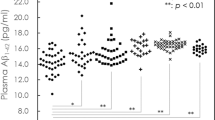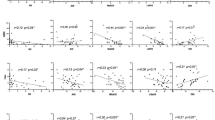Abstract
Purpose
There are currently no biomarkers that are associated with cognitive impairment (CI) in patients with obstructive sleep apnea syndrome (OSAS). This pilot study performed an exploratory plasma proteomic analysis to discover potential biomarkers and explore proteomic pathways that differentiate OSAS subjects with and without CI.
Methods
Participants were selected from a cohort of women within 5 years of menopause not on hormone replacement therapy between the ages of 45–60 years. The Berlin questionnaire was used to select OSAS participants who then completed the MCFSI (Mail-In Cognitive Function Screening Instrument) to measure cognition. Six subjects with the highest MCFSI scores (≥ 5 denoting CI) were compared to six with normal scores. Proteomic analysis was done by Myriad RBM using a targeted ELISA for 254 serum proteins. Pathway analysis of differentially expressed proteins was performed using STRING (Search Tool for the Retrieval of Interacting Genes/Proteins) software.
Results
Distinct proteomic signatures were seen in OSAS subjects with CI as compared to those without CI. Proteins including insulin, prostasin, angiopoietin-1, plasminogen activator inhibitor 1, and interleukin-1 beta were overexpressed in OSAS subjects with CI. Proteins underexpressed in CI participants included cathepsin B, ceruloplasmin, and adiponectin. Pathway analysis revealed prominence of insulin-regulated vascular disease biomarkers.
Conclusions
Proteomic biomarkers in participants with cognitive impairment suggest roles for insulin, and vascular signaling pathways, some of which are similar to findings in Alzheimer’s disease. A better understanding of the pathogenic mechanisms of CI in OSAS will help focus clinical trials needed in this patient population.


Similar content being viewed by others
Abbreviations
- OSAS:
-
Obstructive sleep apnea syndrome
- CI:
-
Cognitive impairment
- SCOR:
-
Specialized center of research
- HRT:
-
Hormone replacement therapy
- MCFSI:
-
Mail-In Cognitive Function Screening Instrument
- AUC:
-
Area under the curve
- STRING:
-
Search Tool for the Retrieval of Interacting Genes/Proteins
- BMI:
-
Body mass index
- AD:
-
Alzheimer’s disease
- IL1B:
-
Interleukin-1 beta
- ELAM-1:
-
Endothelial-leukocyte adhesion molecule 1
- CTSB:
-
Cathepsin B
- APP:
-
Amyloid precursor protein
References
Peppard PE, Young T, Barnet JH, Palta M, Hagen EW, Hla KM (2013) Increased prevalence of sleep-disordered breathing in adults. Am J Epidemiol 177:1006–1014
Bucks RS, Olaithe M, Eastwood P (2013) Neurocognitive function in obstructive sleep apnoea: a meta-review. Respirology 18:61–70
Lal C, Strange C, Bachman D (2012) Neurocognitive impairment in obstructive sleep apnea. Chest 141:1601–1610
Djonlagic I, Guo M, Matteis P, Carusona A, Stickgold R, Malhotra A (2014) Untreated sleep-disordered breathing: links to aging-related decline in sleep-dependent memory consolidation. PLoS One 9:e85918
Torelli F, Moscufo N, Garreffa G, Placidi F, Romigi A, Zannino S, Bozzali M, Fasano F, Giulietti G, Djonlagic I, Malhotra A, Marciani MG, Guttmann CR (2011) Cognitive profile and brain morphological changes in obstructive sleep apnea. NeuroImage 54:787–793
Yaffe K, Laffan AM, Harrison SL, Redline S, Spira AP, Ensrud KE, Ancoli-Israel S, Stone KL (2011) Sleep-disordered breathing, hypoxia, and risk of mild cognitive impairment and dementia in older women. JAMA 306:613–619
Canessa N, Castronovo V, Cappa SF, Aloia MS, Marelli S, Falini A, Alemanno F, Ferini-Strambi L (2011) Obstructive sleep apnea: brain structural changes and neurocognitive function before and after treatment. Am J Respir Crit Care Med 183:1419–1426
Quan SF, Chan CS, Dement WC, Gevins A, Goodwin JL, Gottlieb DJ, Green S, Guilleminault C, Hirshkowitz M, Hyde PR, Kay GG, Leary EB, Nichols DA, Schweitzer PK, Simon RD, Walsh JK, Kushida CA (2011) The association between obstructive sleep apnea and neurocognitive performance—the apnea positive pressure long-term efficacy study (APPLES). Sleep 34:303–314B
Lal C, DiBartolo MM, Kumbhare S, Strange C, Joseph JE (2016) Impact of obstructive sleep apnea syndrome on cognition in early postmenopausal women. Sleep Breath 20:621–626
Walsh SP, Raman R, Jones KB, Aisen PS (2006) ADCS prevention instrument project: the Mail-In Cognitive Function Screening Instrument (MCFSI). Alzheimer Dis Assoc Disord 20:S170–S178
Bade BC, Strange C, Lal C (2014) Effect of obstructive sleep apnea treatment on mail-in cognitive function screening instrument. Am J Med Sci 348:215–218
Lal C, Siddiqi N, Kumbhare S, Strange C (2015) Impact of medications on cognitive function in obstructive sleep apnea syndrome. Sleep Breath 19:939–945
Harris PA, Taylor R, Thielke R, Payne J, Gonzalez N, Conde JG (2009) Research electronic data capture (REDCap)—a metadata-driven methodology and workflow process for providing translational research informatics support. J Biomed Inform 42:377–381
Hanley JA, McNeil BJ (1982) The meaning and use of the area under a receiver operating characteristic (ROC) curve. Radiology 143:29–36
Guenette JA, Raghavan N, Harris-McAllister V, Preston ME, Webb KA, O’Donnell DE (2011) Effect of adjunct fluticasone propionate on airway physiology during rest and exercise in COPD. Respir Med 105:1836–1845
Gylling H, Hallikainen M, Pihlajamaki J, Simonen P, Kuusisto J, Laakso M, Miettinen TA (2010) Insulin sensitivity regulates cholesterol metabolism to a greater extent than obesity: lessons from the METSIM study. J Lipid Res 51:2422–2427
Kleinridders A, Ferris HA, Cai W, Kahn CR (2014) Insulin action in brain regulates systemic metabolism and brain function. Diabetes 63:2232–2243
Talbot K, Wang HY, Kazi H, Han LY, Bakshi KP, Stucky A, Fuino RL, Kawaguchi KR, Samoyedny AJ, Wilson RS, Arvanitakis Z, Schneider JA, Wolf BA, Bennett DA, Trojanowski JQ, Arnold SE (2012) Demonstrated brain insulin resistance in Alzheimer's disease patients is associated with IGF-1 resistance, IRS-1 dysregulation, and cognitive decline. J Clin Invest 122:1316–1338
Claxton A, Baker LD, Hanson A, Trittschuh EH, Cholerton B, Morgan A, Callaghan M, Arbuckle M, Behl C, Craft S (2015) Long acting intranasal insulin detemir improves cognition for adults with mild cognitive impairment or early-stage Alzheimer's disease dementia. J Alzheimers Dis 45:1269–1270
van Oijen M, Okereke OI, Kang JH, Pollak MN, Hu FB, Hankinson SE, Grodstein F (2008) Fasting insulin levels and cognitive decline in older women without diabetes. Neuroepidemiology 30:174–179
Schreitmuller B, Leyhe T, Stransky E, Kohler N, Laske C (2012) Elevated angiopoietin-1 serum levels in patients with Alzheimer's disease. Int J Alzheimers Dis 2012:324016
Pugh CW, Ratcliffe PJ (2003) Regulation of angiogenesis by hypoxia: role of the HIF system. Nat Med 9:677–684
Buee L, Hof PR, Delacourte A (1997) Brain microvascular changes in Alzheimer's disease and other dementias. Ann N Y Acad Sci 826:7–24
Fujisawa T, Wang K, Niu XL, Egginton S, Ahmad S, Hewett P, Kontos CD, Ahmed A (2017) Angiopoietin-1 promotes atherosclerosis by increasing the proportion of circulating Gr1+ monocytes. Cardiovasc Res 113:81–89
Vaughan DE (2005) PAI-1 and atherothrombosis. J Thromb Haemost 3:1879–1883
Swardfager W, Lanctot K, Rothenburg L, Wong A, Cappell J, Herrmann N (2010) A meta-analysis of cytokines in Alzheimer's disease. Biol Psychiatry 68:930–941
Nimrichter L, Burdick MM, Aoki K, Laroy W, Fierro MA, Hudson SA, Von Seggern CE, Cotter RJ, Bochner BS, Tiemeyer M, Konstantopoulos K, Schnaar RL (2008) E-selectin receptors on human leukocytes. Blood 112:3744–3752
Diez JJ, Iglesias P (2003) The role of the novel adipocyte-derived hormone adiponectin in human disease. Eur J Endocrinol 148:293–300
Arita Y, Kihara S, Ouchi N, Takahashi M, Maeda K, Miyagawa J, Hotta K, Shimomura I, Nakamura T, Miyaoka K, Kuriyama H, Nishida M, Yamashita S, Okubo K, Matsubara K, Muraguchi M, Ohmoto Y, Funahashi T, Matsuzawa Y (1999) Paradoxical decrease of an adipose-specific protein, adiponectin, in obesity. Biochem Biophys Res Commun 257:79–83
Yamauchi T, Kamon J, Waki H, Terauchi Y, Kubota N, Hara K, Mori Y, Ide T, Murakami K, Tsuboyama-Kasaoka N, Ezaki O, Akanuma Y, Gavrilova O, Vinson C, Reitman ML, Kagechika H, Shudo K, Yoda M, Nakano Y, Tobe K, Nagai R, Kimura S, Tomita M, Froguel P, Kadowaki T (2001) The fat-derived hormone adiponectin reverses insulin resistance associated with both lipoatrophy and obesity. Nat Med 7:941–946
Alvarez VE, Niemirowicz GT, Cazzulo JJ (2012) The peptidases of Trypanosoma cruzi: digestive enzymes, virulence factors, and mediators of autophagy and programmed cell death. Biochim Biophys Acta 1824:195–206
Cataldo AM, Thayer CY, Bird ED, Wheelock TR, Nixon RA (1990) Lysosomal proteinase antigens are prominently localized within senile plaques of Alzheimer's disease: evidence for a neuronal origin. Brain Res 513:181–192
Funding
The SCOR study was funded by NIH grant UL1 RR029882 via the SCOR P50 grant mechanism.
Author information
Authors and Affiliations
Corresponding author
Ethics declarations
Ethical approval
All procedures performed in studies involving human participants were in accordance with the ethical standards of the institutional and/or national research committee and with the 1964 Helsinki declaration and its later amendments or comparable ethical standards.
Informed consent
Informed consent was obtained from all individual participants included in the study.
Conflict of interest
Dr. Lal has received grant support from Jazz pharmaceuticals and Invado pharmaceuticals and is a consultant for Jazz and Cipla pharmaceuticals. Drs. Strange, Hardiman, and Suchit Kumbhare have nothing to disclose.
Rights and permissions
About this article
Cite this article
Lal, C., Hardiman, G., Kumbhare, S. et al. Proteomic biomarkers of cognitive impairment in obstructive sleep apnea syndrome. Sleep Breath 23, 251–257 (2019). https://doi.org/10.1007/s11325-018-1693-8
Received:
Revised:
Accepted:
Published:
Issue Date:
DOI: https://doi.org/10.1007/s11325-018-1693-8




